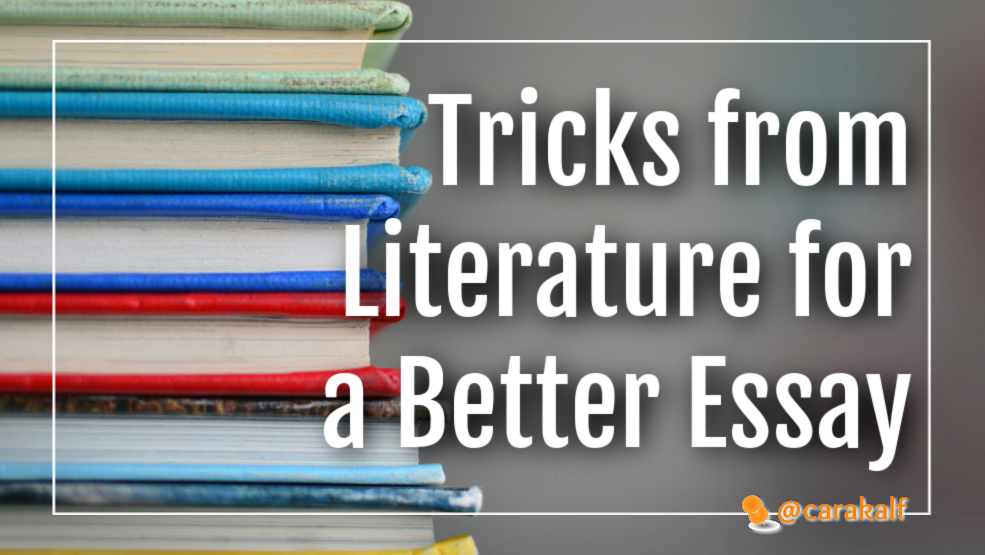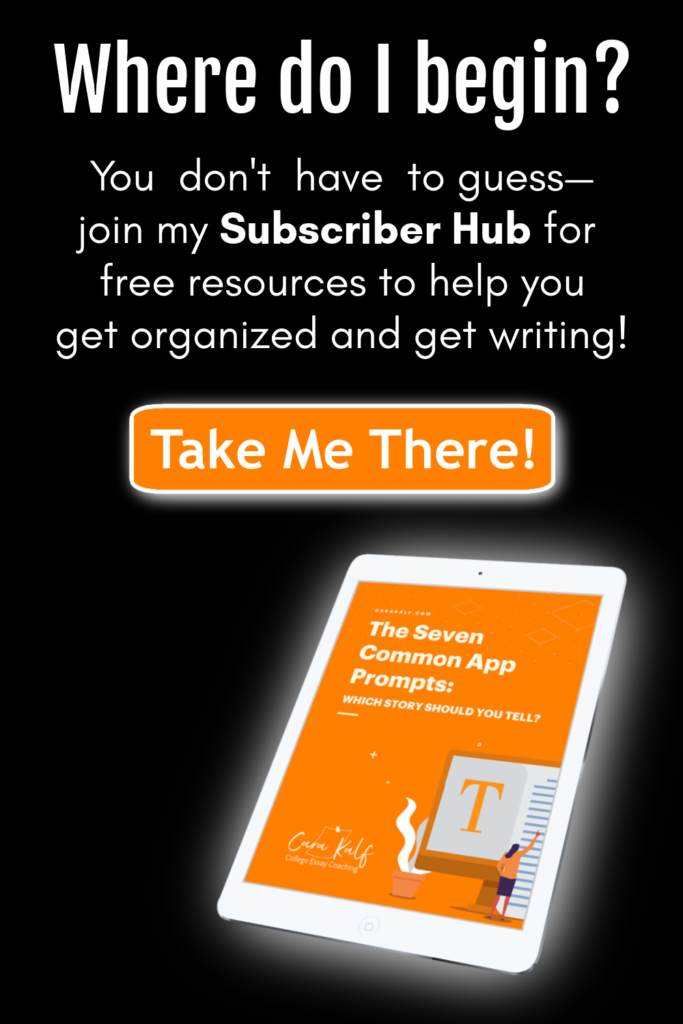You’ve probably already noticed that most of what you’re doing in high-school English is not going to help you write your college essay. Whether it’s a five-paragraph essay or poetry analysis, it’s neither the structure nor the style you need. But that doesn’t mean the study of literature can’t help you. Your story is true, not fiction … but it’s a story, just the same, and that means that you can use what you’ve learned about stories to improve this one.
Tricks from English Class
When you’ve finished an extensive free write about your topic, including as many details as you remember, let it sit for a few days. Then come back to it as though you are reading a novel for English class. You will find several literary elements coming through as though you had planned them—because to a greater or lesser degree, some aspects of literature are organic to all writing. And your awareness of these aspects and clever use of them will make your essay stronger.
All the World’s A Stage: Dramatic Irony
Dramatic irony is the effect created by the reader knowing something the character does not. The quintessential example is the contrast between the awareness of a viewer and a horror movie character. When the character chooses to walk down a dark street alone, the audience screams: “Don’t do it! How could she be so stupid?!” Well, it’s easy, actually—she didn’t know she was the main character in a horror movie. You did.
This effect will play out in your college essay, too. Although you’re telling a true story from your life, you are the main character, and the reader will understand that something important is going to happen—otherwise you wouldn’t be writing about it.
So spare them lines like, “Little did I know, my life was about to change.” Use your reader’s intuitive awareness of the situation to save yourself words. If you want to be humorous (and it fits your overall style and tone), go ahead and make a joke with them like, “I thought I was prepared for what was coming next.” It’s still not necessary, but it at least acknowledges the dramatic irony, inviting them to laugh with you at your younger self. It says to the reader, “I didn’t see this next part coming—but I know you do.”
Teach Them a Lesson: Theme
“What is theme?” I asked my seventh-graders many years ago. A girl in the front row raised her hand.
“It’s something you copy.” I was perplexed. I wanted to give her some way of saving face, but I wasn’t sure if there was any way to do so for an answer that seemed so completely wrong. I tried, “Can you explain some more?”
She started blushing, but she continued, “You know, like a birthday party? Like a mermaid theme, or a My Little Pony theme?”
Suddenly, her answer made perfect sense. She had not given a correct literary definition, but she had made her answer clear, and what’s more, made a legitimate connection to the real world—one I had never noticed.
At some level, theme really is “something you copy, like a birthday party,” because it’s the aspect of the story that’s universal—the message that transcends the particulars of any one piece. Authors don’t sit down and ask, “How can I tell a story that will give the same message as The Wizard of Oz with different characters?” or “How can I use the message of The Wizard of Oz to write a story of my own?” Yet “There’s no place like home” is a classic theme in literature. And when you get to the end of a No Place Like Home book, you don’t think, “Well, they just copied that from The Wizard of Oz!” You think, “Of course! There really is no place like home!” (OK, probably not in those exact words. But I think you get my point.)
So themes are expansive—they speak to more than one time, place or situation. If we use the birthday party metaphor, consider a 7-year-old and a 27-year-old having Harry Potter birthday parties. The child’s party might be more likely to play Pin the Tail on the Dragon, the adult party to play Trivial Pursuit: Harry Potter edition. The child’s party might feature chocolate frogs and every-flavor beans; the adult might make a Hogwarts-style feast using authentic British recipes. (What does treacle tart taste like, anyway?) Both are staying true to the same theme, but the result is entirely different.
English teachers often can’t resist presenting theme as the message or moral of the story, as though the author set out to teach readers a lesson. But American novelist John Gardner said message is “a word no good writer likes applied to his work.” The story creates a lesson for you not because the author asked, How can I teach this lesson? but because—stories teach lessons.
When you write your true story, a theme will emerge organically because stories teach lessons. So when you’re reading your initial brainstorm, look at the story and ask what it’s telling you. If you’re writing a Prompt 2 story about failure, the theme will almost certainly be the prompt itself: “The lessons we take from failure can be fundamental to later success.” That doesn’t mean your topic is cliché or overdone, it means the theme is universal and you are correctly answering the prompt. In the same way, the reader does not need to be surprised that you learned a lesson from your failure, as long as they are enjoying the trip. And you do not need to insult their intelligence by clarifying for them at the end that you learned something from your experience. Just SHOW them how you are different.
In the same way, you can tell a Prompt 3 story in which you learn that “Challenging a belief can make it stronger than it was before”—a lesson any of us might realize without much effort—and it will still be a meaningful lesson if the details of the story show why that wasn’t as easy in practice as it sounds. The trick is to not let the potential cliché of the theme overpower the original, unique experience. You do this by making sure all of the details are true and yours.
Clever Little Touches: Foreshadowing & Symbolism
Foreshadowing is a clue an author drops into a story that sets up an event that will happen later. You might think it’s impossible for there to be foreshadowing in your real life, but you have the benefit of hindsight—when you look backward, it’s easy to see patterns developing that you didn’t notice as they were happening. So when you read your freewrite, look for the first clues that you would one day challenge a belief or tackle a particular difficult task. Let the reader follow the thread.In a similar vein, symbolism can grow out of real-life experiences—you don’t have to put it there self-consciously. If you read your freewrite with an eye for details, you can more easily find the symbolism that’s waiting for you. Why did you mention that raincoat? Why did you choose to tell about the old car, or the weather that day? Imagine you wrote about your path to Varsity soccer. In order to make the team, you had to run a 6-minute mile. Every day, all summer long, you started your morning at the high-school track. When you arrived at try-outs in the fall, the track felt like an old friend, and you were ready for the run. What did the track come to symbolize for you? How can you incorporate that into your essay through subtle description, rather than patronizing explanation?
At the same time, it’s important not to create a symbol because you believe your essay will sound smarter with one. Essays don’t need symbols, and a forced symbol is obvious to a reader.
Read more:What NOT to Write in Your College Essay
Putting It All Together
Elements like symbolism and theme don’t have to be heavy-handed, shoved in the reader’s face to make a point. If you let them, the ones you need will emerge organically in the telling of your story. So start by telling it, no matter how many words it takes. When you come back later to read it, imagine it was written by a stranger. Imagine your English teacher offering commentary on this writer’s choices and the literary elements this thoughtful writer used. Now when you edit, cut away the fluff to let those excellent techniques shine.
(Photo by Kimberly Farmer on Unsplash)


